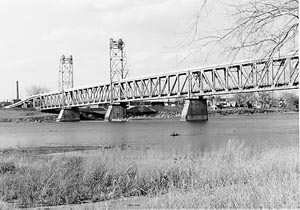U.S. Department of Transportation
Federal Highway Administration
1200 New Jersey Avenue, SE
Washington, DC 20590
202-366-4000
Nebraska Division
Cedar County
Meridian Bridge
| US Hwy 81 over the Missouri River Just South of Yankton, South Dakota Cedar County, Nebraska Total Length: 3013 ft. Roadway Width: 33 ft. 19-Span, Double Deck, Riveted Pratt Vertical-Lift Truss with Pratt Through Truss BUILT: 1924 by the Kelly Atkinson Company S081 21468 |

|
Carrying U.S. Highway 81 over the Missouri River, the Meridian Highway Bridge connects Yankton, South Dakota, with rural Cedar County. Prior to the bridge's completion in 1924, transportation across the Missouri River at this point relied on either ferry service, inaugurated in 1870, or a seasonally operated pontoon bridge, installed in 1890. To protect against ice damage, the pontoon structure was disassembled each year before winter freeze and spring thaw and then rebuilt when the pontoons could be placed on open water or firm ice. The disruption was particularly troublesome for Yankton merchants courting northern Nebraska trade.
In 1915 Yankton business interests organized a private bridge company and gained federal approval to build a permanent bridge across the Missouri. The enterprise lapsed during World War I., but it was revived in 1919 by local seed merchant D.B. Gurney. The proposed bridge would be one of the last major links in an international highway running from Winnipeg, Canada, to Mexico City, Mexico. Since this road followed the Sixth Principal Meridian, it was commonly called the "Meridian Highway." The Yankton boosters named both their bridge company and bridge after the route.
In January 1920 the Meridian Highway Bridge Company retained Kansas City engineers Harrington, Howard and Ash to design a combined railroad and highway bridge, with a movable span to allow unobstructed navigation. Established in 1914 with John Lyle Harrington as senior partner, the firm was respected for its movable bridges. While in a previous partnership with venerable bridge engineer J.A.L. Waddell, Harrington had helped develop a major movable type, which is still known as the Waddell and Harrington Vertical Lift.
The Waddell and Harrington design operated on the same principal as a counterbalanced window sash. It employed, according to the company, "a simple span equipped with machinery for operation, suspended at each end by wire ropes which pass over sheaves on towers and connect to counterweights about equal to the span weight." In its plans for the Yankton bridge, the engineers incorporated a standard, Waddell and Harrington vertical-lift span, measuring 250 feet in length with a maximum lift of 27 feet. Like the bridge's six fixed spans, the movable span was a heavy, rigid-connected Pratt truss with flat upper chords, predominantly channel-section web, and concrete piers.
The trusses were approached by trestles on both shores. They were configured with two concrete decks: an upper level above the top chord for highway traffic and a lower level, just above the bottom chord, for railroad traffic.
The company had originally hoped to finance the bridge through a stock subscription, which would be repaid from toll revenues. But the venture was still several hundred thousand dollars shy of the estimated cost when in the fall of 1920 it contracted for substructure work with the Missouri Valley Bridge and Iron Company of Leavenworth, Kansas. When the substructure was completed two years later, the company still had not raised all the necessary capital. Work was suspended until the fall of 1923, when theKelly Atkinson Company of Chicago began erecting the superstructure.
Fabricated by the American Bridge Company, the steelwork was completed the following spring, and the lift span was raised for the first time in July. When the bridge was officially opened to traffic in October 1924, the total cost stood at more than $1.1 million. Although the lower deck was equipped with trackage, the anticipated rail route never materialized, and the bridge carried only highway traffic.
Completion of the Meridian Highway Bridge was an undisputed boon for the Yankton region, but it proved far less profitable for the bridge company's shareholders, who earned only about 2 percent on their investment over a twenty-year period. In 1946, the company agreed to sell the toll bridge to the City of Yankton for $700,000. After recouping the expense through toll collection, the city turned the bridge into a free facility, which was subsequently taken over by the State of South Dakota. Toll-collecting ceased in 1953, the same year that the bridge's previously idle lower deck was converted into a highway lane, allowing one-way traffic on both levels.
In 1969 the bridge's south approach was partially rebuilt. All of the remaining approach spans were replaced in the early 1980s, creating the present configuration of seven steel-girder shore spans on the north, twelve on the south. At that time the lift span was deactivated and the counterweights removed from the towers. These later alterations were supervised by the Nebraska Department of Transportation, although the bridge remains in South Dakota ownership.
Despite its modifications, the Meridian Highway Bridge retains the original configuration of its seven, steel-truss river spans, including the distinctive towers of the vertical-lift span. It is today distinguished as the only vertical lift span in Nebraska and South Dakota. And as the first permanent crossing of the Missouri River and a link on a major north-south route the bridge has played a significant role in the development of the region's transportation and commerce.